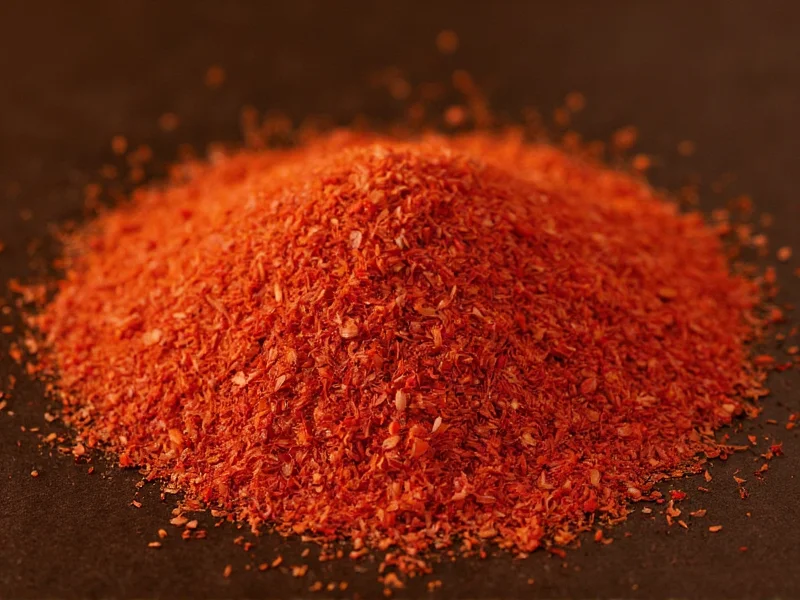Understanding the Scoville scale measurement for red chili flakes helps home cooks and culinary professionals make informed decisions about heat levels in their recipes. Unlike single-variety peppers with defined Scoville ranges, red chili flakes present unique measurement challenges due to their composite nature.
What Determines Red Chili Flakes Scoville Rating
Red chili flakes aren't made from a single pepper variety but typically combine several dried red chilies. The most common components include:
- Cayenne peppers (30,000-50,000 SHU)
- Red jalapeños (2,500-8,000 SHU)
- Red serranos (10,000-23,000 SHU)
- Crushed red pepper varieties
The final Scoville rating depends on multiple factors:
- Pepper blend composition - The specific mix of chili varieties significantly impacts overall heat
- Seed and membrane content - These parts contain most capsaicin, the compound responsible for heat
- Processing methods - Drying techniques and storage conditions affect capsaicin concentration
- Regional variations - Climate and soil conditions where peppers are grown influence heat levels
Comparing Red Chili Flakes to Other Heat Sources
Understanding where red chili flakes fall on the heat spectrum helps with recipe substitutions and heat management. The following table shows how they compare to other common chili products:
| Chili Product | Scoville Heat Units | Heat Comparison to Red Chili Flakes |
|---|---|---|
| Red chili flakes (standard) | 1,000-15,000 SHU | Baseline |
| Paprika | 0-500 SHU | Significantly milder |
| Cayenne pepper powder | 30,000-50,000 SHU | 2-5 times hotter |
| Red pepper flakes (premium) | 15,000-30,000 SHU | Somewhat hotter |
| Chipotle powder | 2,500-8,000 SHU | Similar heat, smokier flavor |
Practical Cooking Applications
Knowing the Scoville measurement range of red chili flakes helps determine appropriate usage in various culinary applications. For home cooks wondering how hot are red chili pepper flakes on Scoville scale, consider these practical guidelines:
When substituting red chili flakes in recipes, remember that 1/4 teaspoon of standard red chili flakes generally equals one fresh red jalapeño. However, heat tolerance varies significantly between brands, so always start with less than you think you need and adjust gradually.
Professional chefs measuring red pepper flakes Scoville units for recipe development should conduct small-batch tests with their specific brand before scaling up production. The capsaicin distribution in flakes isn't uniform, so shaking the container before use ensures more consistent heat levels.
Factors Affecting Heat Consistency
Several elements influence the consistency of heat in red chili flakes:
- Storage conditions - Exposure to light, heat, and moisture degrades capsaicin over time
- Particle size - Finer grinds expose more surface area, potentially increasing perceived heat
- Age of product - Heat diminishes gradually during storage (approximately 15-20% per year)
- Brand formulation - Some manufacturers add maltodextrin or other ingredients that affect heat perception
For those researching what is the Scoville rating for crushed red pepper, it's important to note that "crushed red pepper" and "red chili flakes" are often used interchangeably, though some premium products may specify particular pepper varieties that affect the heat profile.
Measuring Heat Perception vs. Scientific Measurement
The Scoville scale originally relied on human taste testers, but modern measurements use high-performance liquid chromatography (HPLC) for precise capsaicin quantification. This scientific approach reveals why red chili flakes Scoville measurement varies between testing methods.
Human perception of heat differs from laboratory measurements due to:
- Individual tolerance variations
- Food matrix effects (fat content, acidity, etc.)
- Adaptation during consumption
- Capsaicin distribution within the flakes
When following recipes specifying red pepper flakes heat level comparison, consider both the scientific measurement and your personal heat tolerance. The same Scoville rating may feel significantly hotter in a light broth than in a creamy sauce.
Storage and Shelf Life Considerations
To maintain consistent heat levels in your red chili flakes:
- Store in airtight containers away from light and heat
- Use within 6-12 months for optimal heat retention
- Keep away from humidity sources (like above the stove)
- Consider freezing for long-term storage (up to 2 years)
Understanding how long do red chili flakes retain Scoville heat helps maintain recipe consistency. Properly stored flakes lose approximately 15-20% of their heat annually, so older containers will require slightly larger quantities to achieve the same heat level.
FAQ Section
What is the average Scoville rating for most store-bought red chili flakes?
Most commercial red chili flakes measure between 5,000-10,000 Scoville Heat Units, though the range can extend from 1,000-15,000 SHU depending on the specific pepper blend and processing methods used by different manufacturers.
Why do red chili flakes have such a wide Scoville range compared to single pepper varieties?
Red chili flakes typically contain a blend of different dried pepper varieties, each with their own heat range. The proportion of seeds and membranes (which contain most capsaicin), growing conditions, and processing methods all contribute to significant variation between brands and even between batches of the same brand.
How can I determine the actual heat level of my red chili flakes?
The most reliable method is gradual testing in cooking. Start with half the recommended amount in a recipe, taste, and adjust incrementally. Commercial Scoville ratings are averages and don't account for the uneven distribution of capsaicin within a container. Shaking the container before use helps distribute heat more evenly.
Are red chili flakes the same as crushed red pepper?
Yes, red chili flakes and crushed red pepper generally refer to the same product - dried, crushed red chilies. Some premium products may specify particular pepper varieties, but most standard grocery store products use these terms interchangeably regardless of the specific Scoville heat measurement.
How does the heat of red chili flakes compare to fresh chili peppers?
Generally, 1/4 teaspoon of red chili flakes equals one fresh red jalapeño in heat. However, dried chilies concentrate capsaicin during the drying process, so ounce for ounce, dried flakes are hotter than their fresh counterparts. The exact conversion depends on the specific pepper varieties used in the flakes.











 浙公网安备
33010002000092号
浙公网安备
33010002000092号 浙B2-20120091-4
浙B2-20120091-4